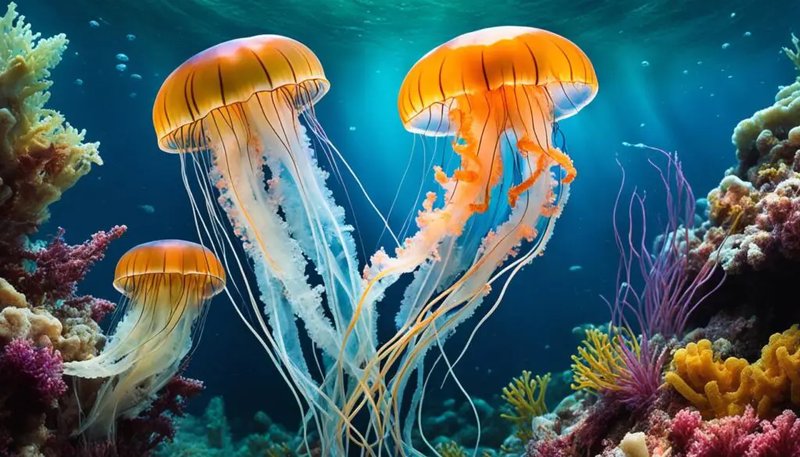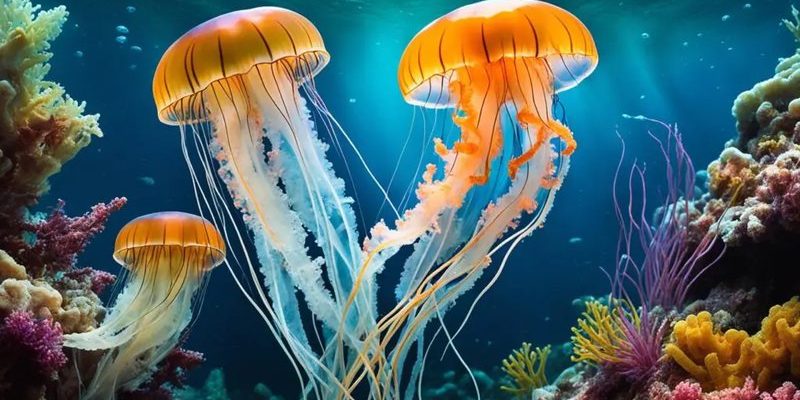
These gelatinous animals come in many shapes and sizes, and they’re more widespread than you might think. You might picture them only lounging in tropical waters, but jellyfish thrive in various habitats, including coastal areas and even some rivers. Let’s dive into their homes and explore where jellyfish are found across the globe.
Oceans: The Main Habitat of Jellyfish
Oceans are the primary home for jellyfish, and it’s where you’ll find the greatest variety. They thrive in both warm and cold waters, from the shallow coastal regions to the deep sea. What makes oceans so perfect for these creatures? Well, for starters, the vastness of the ocean provides countless environments and food sources. Jellyfish feast on plankton, small fish, and even other jellyfish.
In warmer waters, like those found in tropical regions, jellyfish populations can explode. Here’s the thing: warmer temperatures can cause blooms, where jellyfish appear in large numbers. This can lead to breathtaking (and sometimes alarming) sights. For example, in the Sea of Japan or the Caribbean, jellyfish blooms can create a stunning spectacle, turning the water into a shimmering tapestry.
Not only do jellyfish inhabit the sandy bottoms of coastal areas, but they also drift near the surface, where sunlight penetrates. This allows them to catch their food more efficiently. They use their tentacles to capture prey as it floats by, which is why you often see them in areas rich in plankton.
Coastal Regions: A Jellyfish Paradise
Coastal regions, where the ocean meets the land, are another popular habitat for jellyfish. These areas provide a blend of nutrients from both the sea and rivers, which supports rich marine life. Jellyfish love to hang out near estuaries, where fresh and saltwater mix.
In places like the Chesapeake Bay and the Gulf of Mexico, jellyfish are not uncommon sights during the warmer months. The nutrients brought by rivers and currents create a buffet for jellyfish, and they can often be seen floating along shorelines. Think about it: if you’re walking along the beach, there’s a good chance you could spot a jellyfish bobbing in the waves.
Coastal jellyfish also have to deal with the challenges of human activity. Pollution and overfishing can affect their food supply, which is why conservation efforts are becoming increasingly important in these areas. Protecting coastal habitats ensures that jellyfish and the larger ecosystem remain healthy.
Jellyfish in Rivers: Surprising Freshwater Habitats
You might be surprised to learn that jellyfish aren’t limited to salty oceans. Some species thrive in freshwater environments, like rivers and lakes. One example is the Craspedacusta sowerbii, a species of freshwater jellyfish that originated from China but has now spread to various parts of the world, including the United States and Europe.
These jellyfish are typically small and transparent, making them hard to spot. They can often be found in calm waters, such as small lakes or slow-moving rivers. They don’t have the same vast habitats as their ocean cousins, but they still play a role in their ecosystems, feeding on tiny organisms like zooplankton.
The presence of jellyfish in freshwater can indicate healthy water conditions, but factors like pollution or changes in water salinity can dramatically affect their life cycles. So, if you find yourself by a river or lake, take a closer look—you might just see one of these delicate creatures floating nearby!
Temperature and Habitat Preferences
Temperature plays a significant role in determining where jellyfish can live. Many species prefer warmer waters, often found in tropical and subtropical regions. However, some jellyfish have adapted to survive in colder waters, like the Arctic and Antarctic seas. They are surprisingly resilient and can endure various water conditions, from the frigid temperatures of the North Atlantic to the balmy climates of the South Pacific.
Jellyfish are also known to favor areas with plenty of food, such as coastal waters where upwellings bring nutrients to the surface. This ability to adapt to different temperatures and environments is crucial for their survival, especially as climate change affects ocean temperatures worldwide. The shifting climate can impact jellyfish populations, leading to more blooms or even changes in species distribution.
Understanding these preferences helps researchers predict future jellyfish behavior and populations, which can impact fishing and tourism. If you live in or are visiting a coastal area, keeping an eye out for jellyfish can also alert you to changes in local marine health!
Ecological Impact of Jellyfish Habitats
Jellyfish play a significant role in their ecosystems, and their habitats are crucial for various marine species. They serve as both predators and prey, forming an essential part of the food web. As jellyfish populations rise, they can affect fish populations by competing for food sources.
Interestingly, jellyfish can also benefit the environment by recycling nutrients. Their waste products can support the growth of phytoplankton, which in turn supports a wide range of marine life. However, when jellyfish bloom excessively, it can lead to overfishing of important fish species, which disrupts entire ecosystems.
Some scientists even study jellyfish habitats to understand the broader health of marine environments. By monitoring jellyfish populations, researchers can gauge the impacts of climate change, pollution, and other human activities affecting our oceans.
Conservation and the Future of Jellyfish Habitats
As human activity continues to impact marine environments, the conservation of jellyfish habitats becomes increasingly important. Overfishing, climate change, and pollution can dramatically alter the places where jellyfish thrive. Protecting these habitats ensures the balance of marine ecosystems.
Many organizations are working to raise awareness about the importance of jellyfish and their habitats. This can include everything from beach clean-ups to advocating for sustainable fishing practices. The more we understand about where jellyfish are found and how they interact with ecosystems, the better equipped we are to protect them.
While jellyfish might seem like simple creatures, they are integral to the health of our oceans. By supporting conservation efforts, we can help ensure that future generations get to marvel at these beautiful beings.
In conclusion, jellyfish are far from being just ocean dwellers. They inhabit various environments, from coastal areas to, surprisingly, rivers. Their presence provides essential insights into the health of marine ecosystems. By learning about where jellyfish are found, we can appreciate their unique roles and advocate for their protection in an ever-changing world. So next time you’re near a body of water, take a moment to look for these mesmerizing creatures and remember their vital place in our ecosystem!

